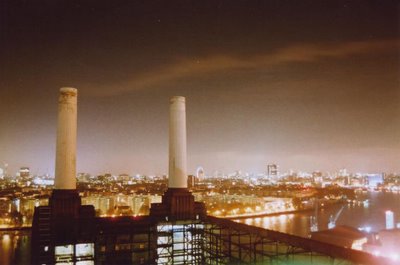|
|
"War, however tragic, is often a source of architectural invention," writes Farès el-Dahdah. "Beirut's recent civil warfare produced many such inventions," he suggests. "Black drapes, eight stories high and hung across urban interstices shielded pedestrians from the deadly trajectory of a sniper's view so as to veil one fighting camp from another. Shipping containers were filled with sand and arranged as divisive labyrinths along frontlines... Entering a building became an oblique experience as one was forced to slither sideways behind oil barrels filled with concrete. War is inevitably linked with architectural experience..." 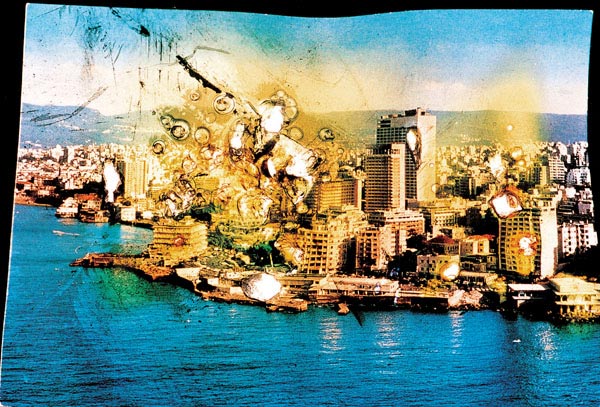 [Image: From Wonder Beirut, 1997-2004, by Joana Hadjithomas and Khalil Joreige]. [Image: From Wonder Beirut, 1997-2004, by Joana Hadjithomas and Khalil Joreige].According to architect Rodolphe el-Khoury in an article for Alphabet City #6, "In Beirut's centre-city, where the busiest and densest structures once stood, now lies an empty field... a tabula rasa at the very heart of the city. This cleared ground has no discernible physical differentiation: all traces of streets and building masses are now erased. Also obliterated are the property lines, zoning envelopes and other invisible but no less 'real' demarcations which customarily determine or reflect urban morphologies."  The larger, urban-geographic effects of war are well-described in this article by Katja Simons: "In the years of war, Beirut was divided along ideological and religious lines. A new mental map of the city emerged. The city was renamed East and West Beirut and was divided by the Green Line of demarcation... Self-sufficient sub-centers developed in different parts of the city, preventing civic interaction throughout Beirut. People fled the city and moved to safer places at the periphery. Shop owners and businesses followed, moving to the coastal areas north of the city where new suburban commercial centers mushroomed." A new geography of investment soon followed; and, beyond the bombs, Beirut's infrastructure was transformed. These internal erasures also affected the city's natural coastline. The port of Beirut, for instance, served as a dumping ground for rubbish, as disposal of waste by other means was too dangerous. A moving coastline of garbage slowly infilled the sea.  [Image: By Gustafson Porter]. [Image: By Gustafson Porter]."The shoreline of Beirut has continuously evolved throughout history," a landscape proposal by Gustafson Porter explains. In that proposal, Beirut's "lost city coastline has become the inspiration for the creation of a series of new urban spaces." 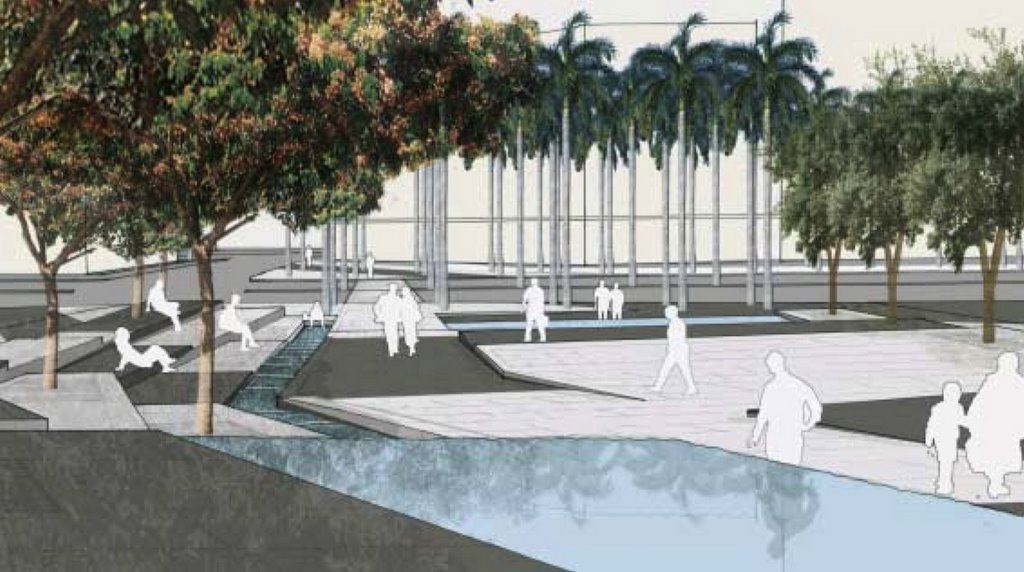 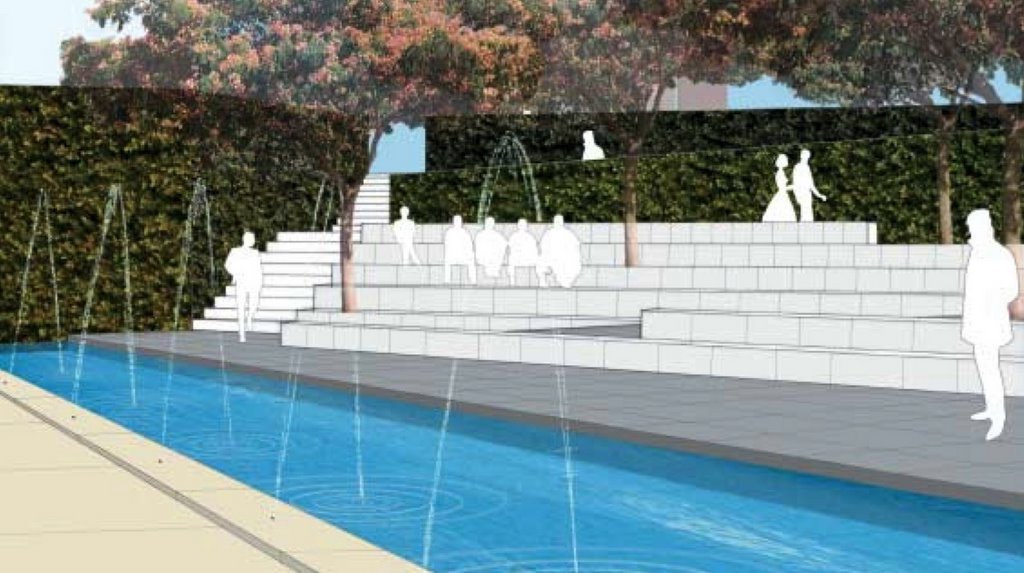 [Images: By Gustafson Porter]. [Images: By Gustafson Porter]."Within the historic context of the evolving shoreline, Gustafson Porter has suggested a new line... revealing elements of the changing historical coastline and acting as a connective spine. On the ground it is marked by a continuous line of white limestone that is accompanied by a wide pedestrian promenade lined by an avenue of distinctive palms ( Roystonia regia)." (Download their PDF for more).  [Image: By Gustafson Porter]. [Image: By Gustafson Porter].What's interesting here is the idea of building a new coastline, internal to the city. Framing that as a walk, an urban unit, and then leading people along this imagined shore. A new outside, inside. All the old Devonian coastlines of Manhattan recreated for a day by a series of guided walks. You can download an MP3; it tells you how deep the water was at the corner of Front and John. Where reefs once grew. Marking those with white limestone: here was the sea... BLDGBLOG Presents: The Paleo-Coastal Walkway, a new guide to the lost seas of Manhattan.  [Image: Bernard Khoury, Checkpoints, 1994]. [Image: Bernard Khoury, Checkpoints, 1994].In any case, Lebanese architect Bernard Khoury seems to view war as architecture pursued by other means. (Or perhaps vice versa). Khoury, for instance, directly confronts the architecture of military control in a series of sci-fi urban checkpoints: "Our proposal plans for high-tech retractable and inhabitable structures that include monitoring systems. While at rest, the checkpoints are dissimulated below the tarmac, they are brought back above the surface when their operators are on duty. The checkpoints establish new roadmaps, they create another battlefield through which the whole territory is linked. The public transits through the selected points in the city, moves into the matrix to be referenced, crosschecked."  [Image: Bernard Khoury, B018, 1998]. [Image: Bernard Khoury, B018, 1998].Khoury's most famous work, however, is the Beiruti nightclub, B018, which melds an urban, post-war bunker aesthetic with the world of hydraulic disco: "The project is built below ground. Its façade is pressed into the ground to avoid the over exposure of a mass that could act as a rhetorical monument. The building is embedded in a circular concrete disc slightly above tarmac level. At rest, it is almost invisible. It comes to life in the late hours of the night when its articulated roof structure constructed in heavy metal retracts hydraulically. The opening of the roof exposes the club to the world above and reveals the cityscape as an urban backdrop to the patrons below." Checkpoints, bunkers, new walkways, moving coastlines, oblique forms of entry – architectural responses to urban warfare could take up a whole website of their own. It's a theme I'll return to. For a bit more reading, meanwhile, check out this paper on war and anxiety, from the excellent Cabinet Magazine.
Perhaps this answers the question of what remains once civilization blows away:  [Image: "DESTIN, Fla. – A swimming pool stands alone on the beach near Destin, Fla., Monday, July 11, 2005, after having been separated from the building complex by the effects of Hurricane Dennis passing through the area on Sunday." WFTV]. Ruined swimming pools. On stilts. A few minutes' walk from the sea.
 [Image: A scene from Deep Impact]. Will civilization end? Will the planet be destroyed? Will a hundred cities burn? Just consult the Torino Scale. The Torino Scale is supposedly a "Richter scale for earth impact hazards." It's been freshly revised to inform us how worried we should be about near-earth objects in space – it's even color-coded.  [Image: NASA; click on to enlarge – but surely number 10 is not the worst it can get? Are they withholding parts 11-20? Earth splits in two. The solar system is destroyed. The universe disappears]. Meanwhile, they need Torino Scale: BLDGBLOG Edition. It tells you what sorts of hazards to expect if someone starts hurling architectural masterpieces at the earth. Saarinen's TWA terminal – wham! Your house shakes. Philip Johnson's – ooh: that's not a masterpiece. The Great Wall of China – close one. The ground is still shaking. The Eiffel Tower. St. Paul's. The entirety of Manhattan?!Robo-Venice! [Image: Let's see what President Freeman has to say... (from Deep Impact)].
"Each second," the New York Times reports, "about a cubic yard of new mountain—roughly a pickup truck's worth—is pushed to the surface [of Mount St. Helens], adding to a dome growing inside the crater." Each second.
 [Image: "Mount St. Helens, its second dome visible, is being shaken constantly by earthquakes." John S. Pallister/USGS Cascades Volcano Observatory/New York Times]. [Image: "Mount St. Helens, its second dome visible, is being shaken constantly by earthquakes." John S. Pallister/USGS Cascades Volcano Observatory/New York Times].
The mountain, it seems, as evidenced by a recent and ongoing series of minor earthquakes, is undergoing a slow, quiet eruption. "Beneath the mountain," we read, "the magma rises through fractures in the rock from a fairly small magma chamber about five miles below. Beneath that chamber is probably another pipe that taps the deeper mantle."
Those fractures and pipes look something like this:
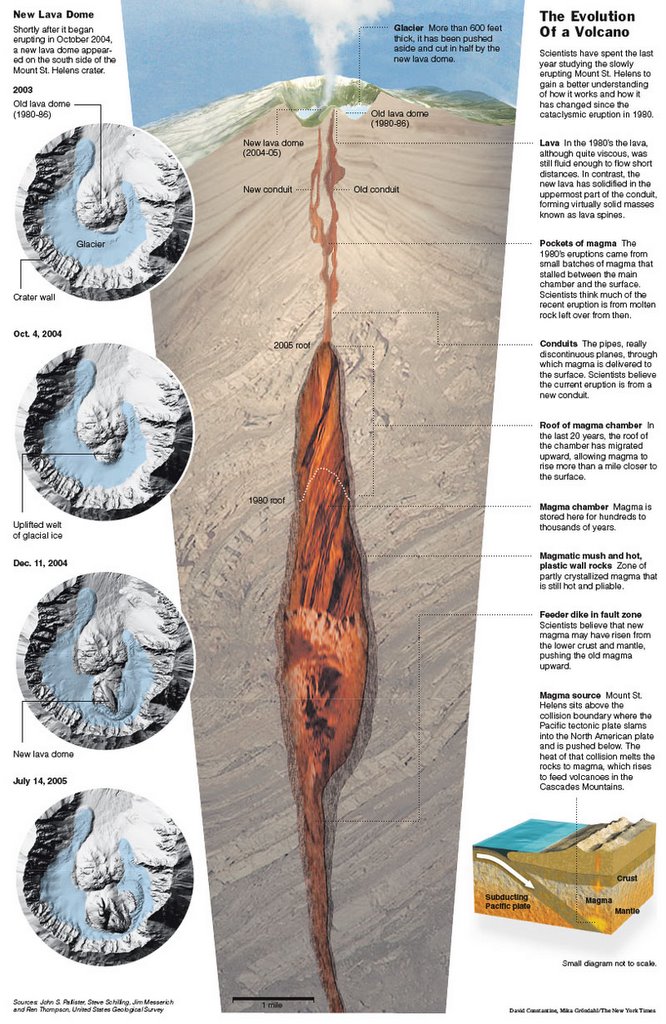 [Image: New York Times; this diagram kicks ass at a larger size]. [Image: New York Times; this diagram kicks ass at a larger size].
Further, "As the current eruption empties the conduit, scientists have detected a slight deflation of the flanks of the volcano, though not quite as much as predicted, which suggests that the chamber has partially been refilled by new magma."
The insane thing here is that one of the scientists profiled in this article knows that the magma chambers are refilling because he has found fresh glass on the mountainside. I can't help but wonder if, at any phase of the earth's history, there might have been whole mountain chains made entirely of glass, translucent, marbled, veined with stained metals and colored by minerals, like cathedral windows in mountain form—
 [Image: ArtLex]. [Image: ArtLex].
—that would would have fractalized sunset into angles and shards, the horizon ablaze. Mountains, shining from within.
Whole islands emerge from the Pacific, made of translucent colored glass. You can watch fish through them. Comets reflect in ripples across their smoothly ridged surfaces. A minor earthquake makes the planet ring like a fragile glass bell.
What species could evolve on glass islands? What would they eat? What would riverbeds look like, and could you watch streams from below? Could you watch treeroots pop slowly, expanding through layers of bedglass? Glass tectonics. The mountains are literally shattering from below.
Or imagine Shelley, arriving by ship at a tropical archipelago made of glass. Thousands of small islands, and he sails between each one. He soon begins a series of epic poems to be published exclusively on BLDGBLOG, inspired by a moonlit tour of ruined glass arches shaped by natural erosion. He carves a cup directly from the mountain and he drinks wine with it. The earth breaks down into transparent soil.
Anyway, the New York Times article also includes this photographic demonstration of the volcanic dome's growth. I guess I just like volcanoes...
Large geoglyphs in the surface of the New Mexican desert have been discovered by an Albuquerque news channel.  [Image: KRQE-TV/Washington Post]. [Image: KRQE-TV/Washington Post].Turns out, the glyphs mark the location of a subterranean archive-complex "built into a mountainside" by the Church of Scientology. The futuristic archive "was constructed to protect the works of L. Ron Hubbard, the late science-fiction writer who founded the church in the 1950s. (...) The archiving project, which the church has acknowledged, includes engraving Hubbard's writings on stainless steel tablets and encasing them in titanium capsules." Ironically, this is exactly what I've been doing with my old BLDGBLOG posts... From the Washington Post: "'Buried deep in these New Mexico hills in steel-lined tunnels, said to be able to survive a nuclear blast, is what Scientology considers the future of mankind,' ABC's Tom Jarriel said in his report. 'Seen here for the first time [are] thousands of metal records, stored in heat-resistant titanium boxes and playable on a solar-powered turntable, all containing the beliefs of Scientology's founder, L. Ron Hubbard.'" 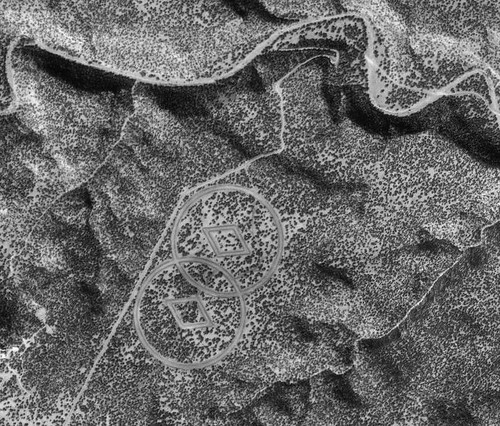 [Image: USGS/Terraserver]. [Image: USGS/Terraserver].But the deep desert glyphs may not only be geographical markers: "Former Scientologists familiar with Hubbard's teachings on reincarnation say the symbol marks a 'return point' so loyal staff members know where they can find the founder's works when they travel here in the future from other places in the universe. 'As a lifetime staff member, you sign a billion-year contract. It's not just symbolic,' said Bruce Hines of Denver, who spent 30 years in Scientology but is now critical of it... 'The fact that they would etch this into the desert to be seen from space, it fits into the whole ideology.'" (With thanks to Javier Arbona for the tip!).
 [Image: "Peter Oppedisano at his home with paved yard in Malba, Queens." Suzanne DeChillo/ New York Times]. "The grassy front lawn, once a staple of the American dream, is steadily being usurped by the pave-over. Many homeowners, opting for grayer pastures, are pouring concrete over their patches of green." Perhaps living proof that you can read too much J.G. Ballard, when "Christina Groza moved from an older building in Astoria, Queens, into a recently built one in College Point, the new home had a major selling point... the original lawn outside the new building had been paved over with concrete." One instantly wonders how many pave-overs you could get away with, and what law it is you'd be breaking if you tried: wait till everyone's away on holiday vacation, wake up your cousins – then pave everything.
 [Image: Replacing the rivers and militarizing the water supply: "Soldiers in Harbin, in northeast China, checked water supplies on Tuesday." Imaginechina/ New York Times]. "On the streets of Harbin, life seemed normal, if somewhat surreal, given that a major metropolitan area of several million people had almost no running water or usable toilets and that thousands of residents seemed to have fled," the New York Times reports. A sign of things to come, then, as China's clean water supplies succumb to industrial pollution: this week China covered-up the fact – then quietly admitted – that a benzene factory had contaminated the Songhua River – which just happens to be the only source of drinking water for the city of Harbin. Or not the only source: there is also the newest river in China, a de-terrestrialized landscape of plastic bottles trucked in from elsewhere, hydrology under military escort. So what is the lesson of Harbin? When a river becomes too polluted, we will simply replace it with bottled water. (Until there is nothing left to bottle). It's the new landscape of militarized world resources.
 Artist Do-Ho Suh replicated the complete interior of his old home in Korea – only he did it using translucent nylon.  He took sewing lessons from old dressmakers so he could assemble the whole thing himself – and then he built another replica: of his apartment in New York City.  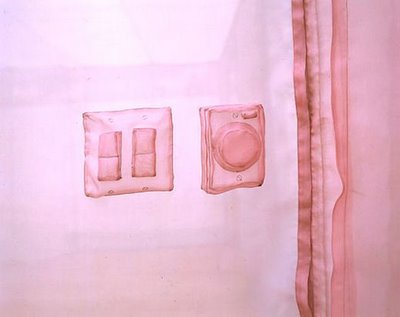 It sounds like the whole thing was inspired by a combination of nostalgia and insomnia; but he talks more about it here, in an interview with PBS.    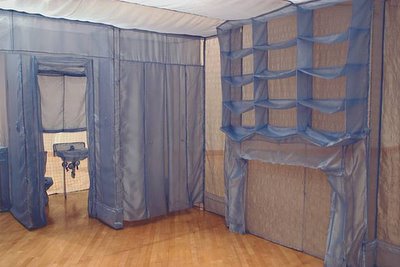 Meanwhile, you can learn more at Brown University and at Artnet – which is where I found these images. (Originally spotted at Blanketfort).
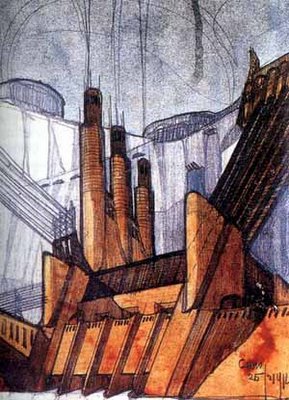 As the Independent reported this morning, England's river Mersey may soon become "the first river in Britain to generate electricity from its tides" – using a tidal fence. 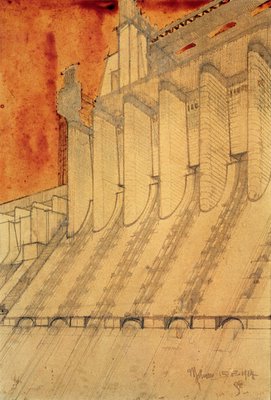 Plans are afoot to take advantage of "the Mersey's vast renewable energy potential by constructing a tidal power fence which, according to initial estimates, could generate up to 2,000 megawatts of electricity, enough to power 15 per cent of the North-west's electricity requirements. The Mersey offers more tidal power potential than virtually any other river in Europe, by virtue of its 10-metre tidal range and strong currents which are a by-product of its shape and its position on England's windy North-west coast." It is, in other words, about to become a machine. 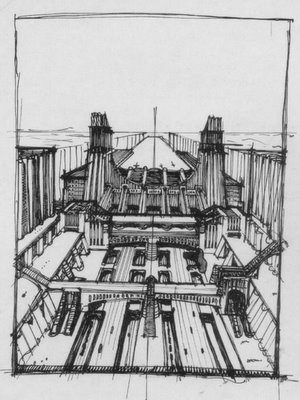 First, water at high tide will be shut into a sequence of locks and gates; in this respect, the tidal fence is not unlike a standard shipping canal. But then, as the river drops with the tide, the trapped water – now at a higher elevation – will be "allowed to escape through the turbines of a hydroelectric plant." This will turn the water's gravitational potential energy into electricity.  Tidal fences, however, are only one technical option – there are also tidal turbines, for example, and there are important differences between turbines and fences. (For more on this, see Daily Kos). But why should we care about tidal power at all? " Tidal power is more dependable than wind due to its predictable nature thus making it a better source of electrical energy for feeding the baseload of the national grid. The tides run almost 6 hours in one direction and then reverse and run for 6 hours in the opposite direction thus giving a power source that is available 24 hours a day unlike wind and solar." Or, as we read in this press release: "Seawater is 832 times as dense as air; therefore the kinetic energy available from a 5-knot ocean current is equivalent to a wind velocity of 270 km/h." The point is that tidal power kicks wind power's a**.  Meanwhile, the technology itself verges on the occult. Norway, for instance, is experimenting with moon power at a new station built by Hammerfest Strøm AS: "The rise and fall of the sea, caused by the Moon's gravitational tug on the Earth, could be generating electricity for hundreds of thousands of homes within five years if the new Norwegian power station proves successful. The power station, which resembles an underwater windmill, began generating electricity for the town of Hammerfest. Although still largely a prototype, the generator is the first in the world to harness the power of the open sea and be connected to an electricity grid." (See the details in their own technical PDF). So, sure, all tides are lunar, and therefore all tidal power is lunar power... but it's still fascinating. It's like something straight out of Aleister Crowley.  Meanwhile, the images that you're seeing scattered throughout this post are all by Italian Futurist architect, Antonio Sant'Elia. Not a single one of them is of a tidal fence, a tidal turbine, or even of a hydroelectric dam; but his obvious exuberance for monumental power-generation structures is: 1) so bizarre it's almost touching; and 2) just waiting to be copied by a new generation of architects, gamers, novelists and filmmakers.  Herculean and abstract concrete structures humming with hydroelectric power. Submerge ten of these things in the Mersey... and England just got a whole lot brighter.
Turns out those plans for elevating Venice aren't even new! 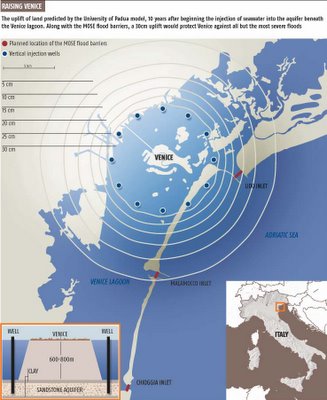 [Image: New Scientist, July 2004; worth clicking on to enlarge]. BLDGBLOG has been doing its homework, and we've found that the New Scientist explained all this way back in 2004: "Venice's problem is largely one of subsidence, both natural and man-made. From the 1930s to the 1970s, fresh water was pumped out of underground reservoirs beneath the city to supply surrounding factories. As the water was pumped out of these aquifers – which are rather like rocky sponges – their water-filled pores compressed and the ground sank. Combined with sea-level changes, this has produced an effective rise in sea level of 23 centimetres over the past 100 years." Thus the whole raise-the-city-with-water-pumps idea. "Numerous plans have been proposed to prevent Venice succumbing to the floodwaters, many of them controversial," New Scientist continues. "But if the latest idea gets the go-ahead it will raise more than a few eyebrows. Rather than trying to control the rising water level by keeping the sea out, engineers at the nearby University of Padua want to lift the entire city out of harm's way by raising the ground upon which it sits." Fair enough. But I still think they should put the whole thing onto an arched labyrinth of mechanized legs – inter-connected offshore oil platforms that can walk – and let the city flee inland by itself. King Kong 2: Contro Venezia! The love-crazed simian dukes it out – with Spider-Venice. 
I was looking at this UPS label when I realized it contains some interesting architectural assumptions.  It offers me a porch, a deck, a garage, a back door, a patio, etc., on which to collect my package. But no cheese cave or tower or footbridge; no Zen rock garden or prefab container village; no offshore Texas tower; no private helipad... How does UPS account for other architectural styles? Oh – you tic Other! Now I get it. The international option. "Just leave it in the harem," I'll say. "Leave that one beneath the torii gate, sir." "Leave it in the Other." It's the UPS Vernacular.
"Italian experts are proposing a dramatic new solution to the watery threat facing the city of Venice," the BBC reports.  "Rather than battling to keep the sea out – they want to use it to help raise the sinking island-city. The scheme would involve pumping huge quantities of sea water into the ground beneath Venice down 12 pipes each of which would be 700m (765 yards) long. The sea water would make the sand beneath the city expand lifting Venice by 30cm (11.8 inches) in 10 years."  This, of course, comes after the so-called "Moses Project," which, as the BBC describes it, is "a series of 78 mobile steel barriers to be activated during exceptionally high tides. The barriers, due to be in place by 2011, will lie on the seabed most of the time, but will be filled with air to create a dam when Venice is threatened."   Of course, soon they'll just put the whole city atop a mechanized webwork of spindly little hydraulic legs that will stand up and walk inland – taking the Bridge of Sighs with it. The fully automated Robo-Venice of the future. Meanwhile, for comparison, there's always the Thames Barrier – 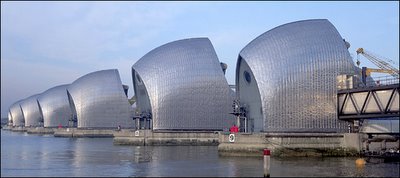  – but everyone knows that won't save us... 
"The team of architects behind the Eden Project in Cornwall is planning to turn a Lancashire rubbish dump into a tropical rainforest which would heat itself with decomposing garden and kitchen waste."
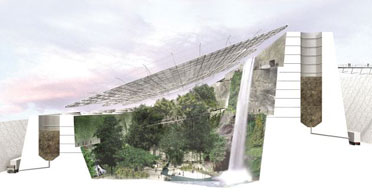
That doesn't excite you?
Well, the plan also "includes one of England's highest waterfalls, walkways through the treetops and possibly Europe's biggest compost heap, capable of using most of the green waste of a city the size of Manchester."
In the previous post – about the films of Stan Brakhage – I complained that you could not make a film using bedrock; but I stand corrected. "It is entirely possible to project light through bedrock," an email I soon received explained. "Thin sections, samples of rock ground to a thickness of 30 microns for viewing under a microscope, are a standard tool of petrology." So I was pointed to a website, did some research – including petrographic imagery at Humboldt State University, a Parisian Atlas minéralogique, and some " plutonic microtextures" at UNC-Chapel Hill – and it's true: you can make your own Mothlight using slices of bedrock. The continental plates as a kind of underground Hollywood. Film in mineral form. Some examples? Just look below: 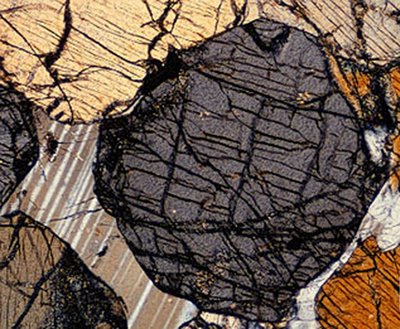  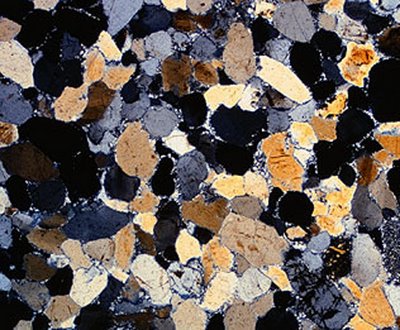 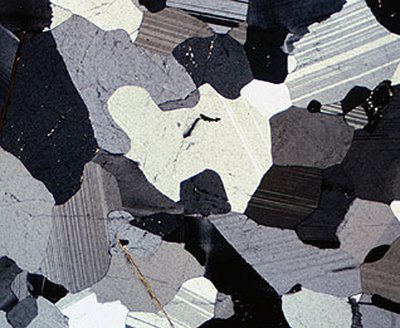   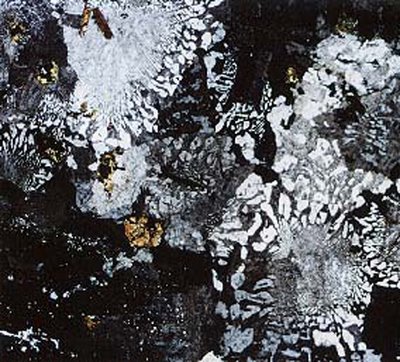 How would you do it? As but one example, you could animate the following sequence – 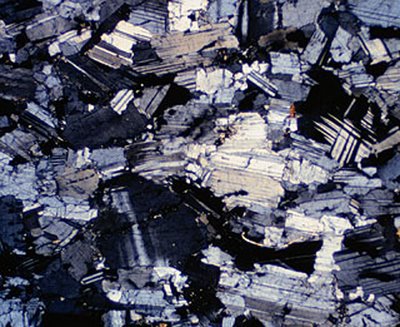 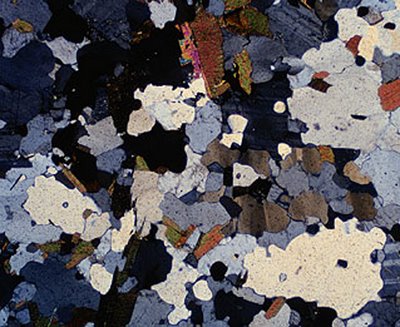 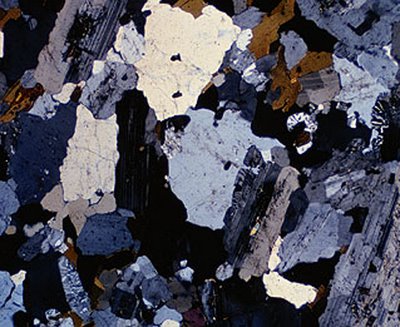 – which would not only display a very obvious sense of visual continuity, it would offer its own short geo-metamorphic narrative: anorthosite becoming gneiss becoming biotite-rich granite. You could explain and demonstrate simultaneously the formational history of the earth, using abstract patterns of mineral imagery. Bedrock: The Film. (Thanks to Mike Weber for the initiating email; and all images above are by Kent Ratajeski at UNC-Chapel Hill).
|
|
 [Image: From Wonder Beirut, 1997-2004, by Joana Hadjithomas and Khalil Joreige].
[Image: From Wonder Beirut, 1997-2004, by Joana Hadjithomas and Khalil Joreige].
 [Image: By Gustafson Porter].
[Image: By Gustafson Porter].
 [Images: By Gustafson Porter].
[Images: By Gustafson Porter]. [Image: By Gustafson Porter].
[Image: By Gustafson Porter]. [Image: Bernard Khoury, Checkpoints, 1994].
[Image: Bernard Khoury, Checkpoints, 1994]. [Image: Bernard Khoury, B018, 1998].
[Image: Bernard Khoury, B018, 1998].




 [Image: "Mount St. Helens, its second dome visible, is being shaken constantly by earthquakes." John S. Pallister/USGS Cascades Volcano Observatory/
[Image: "Mount St. Helens, its second dome visible, is being shaken constantly by earthquakes." John S. Pallister/USGS Cascades Volcano Observatory/ [Image:
[Image:  [Image:
[Image:  [Image: KRQE-TV/
[Image: KRQE-TV/ [Image:
[Image: 










